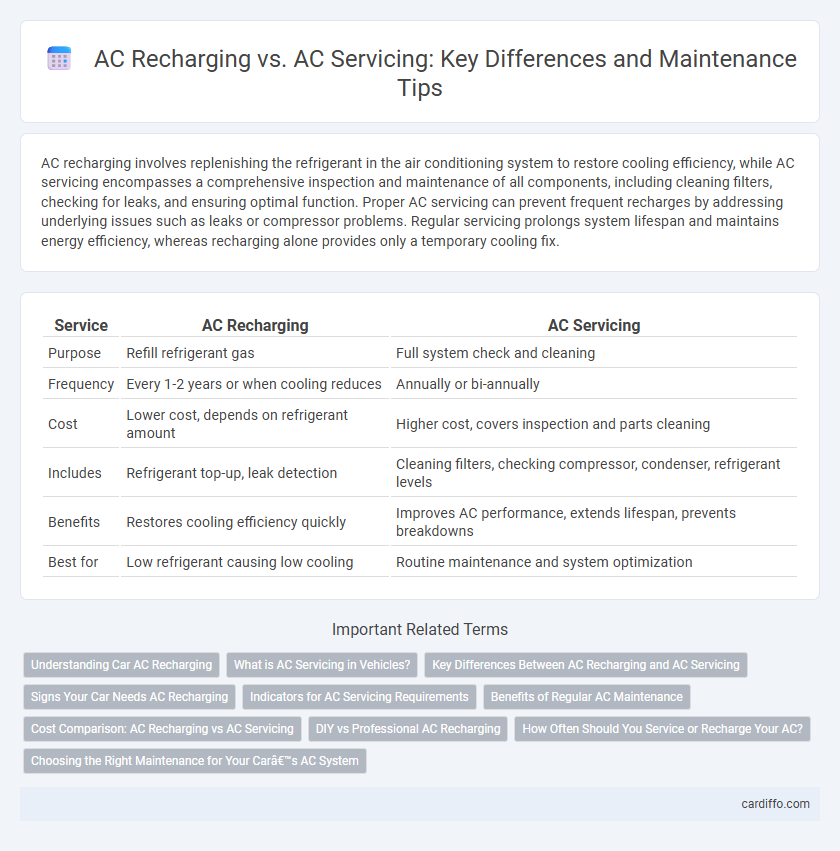AC recharging involves replenishing the refrigerant in the air conditioning system to restore cooling efficiency, while AC servicing encompasses a comprehensive inspection and maintenance of all components, including cleaning filters, checking for leaks, and ensuring optimal function. Proper AC servicing can prevent frequent recharges by addressing underlying issues such as leaks or compressor problems. Regular servicing prolongs system lifespan and maintains energy efficiency, whereas recharging alone provides only a temporary cooling fix.
Table of Comparison
| Service | AC Recharging | AC Servicing |
|---|---|---|
| Purpose | Refill refrigerant gas | Full system check and cleaning |
| Frequency | Every 1-2 years or when cooling reduces | Annually or bi-annually |
| Cost | Lower cost, depends on refrigerant amount | Higher cost, covers inspection and parts cleaning |
| Includes | Refrigerant top-up, leak detection | Cleaning filters, checking compressor, condenser, refrigerant levels |
| Benefits | Restores cooling efficiency quickly | Improves AC performance, extends lifespan, prevents breakdowns |
| Best for | Low refrigerant causing low cooling | Routine maintenance and system optimization |
Understanding Car AC Recharging
Car AC recharging involves replenishing the refrigerant to restore cooling efficiency, making it essential when the system loses its cooling power due to leaks or low refrigerant levels. This process targets the core issue of coolant depletion, whereas AC servicing encompasses a broader range of maintenance tasks, including inspecting components, cleaning filters, and checking for leaks. Understanding car AC recharging ensures timely action to prevent compressor damage and maintain optimal performance during hot weather conditions.
What is AC Servicing in Vehicles?
AC servicing in vehicles involves a comprehensive inspection and maintenance process that ensures the air conditioning system operates efficiently and reliably. This includes checking refrigerant levels, inspecting for leaks, cleaning components, replacing filters, and verifying the functionality of compressors and condensers. Regular AC servicing helps prevent potential breakdowns, enhances cooling performance, and extends the lifespan of the vehicle's air conditioning system.
Key Differences Between AC Recharging and AC Servicing
AC recharging involves replenishing the refrigerant charge in an air conditioning system to restore cooling efficiency, while AC servicing encompasses a comprehensive inspection, cleaning, and repair of components such as filters, coils, and fans to ensure optimal performance. Recharging addresses low refrigerant levels causing poor cooling, whereas servicing prevents potential breakdowns by maintaining all functional parts and identifying underlying issues. Regular servicing extends the lifespan of the AC unit, whereas recharging is typically a reactive maintenance step when cooling efficiency drops.
Signs Your Car Needs AC Recharging
A noticeable decrease in cooling performance and warm air blowing from the vents are clear signs your car needs AC recharging. Frequent fogging inside the windows and unusual hissing noises from the AC system also indicate low refrigerant levels. Ignoring these symptoms can lead to compressor damage, making timely AC maintenance crucial for optimal vehicle comfort.
Indicators for AC Servicing Requirements
Indicators for AC servicing requirements include reduced cooling efficiency, unusual noises from the compressor, and foul odors emanating from the vents. Frequent need for AC recharging often signals underlying issues such as refrigerant leaks or clogged filters that servicing can address. Regular servicing ensures optimal performance by inspecting components, cleaning coils, and checking refrigerant levels beyond merely recharging.
Benefits of Regular AC Maintenance
Regular AC maintenance ensures optimal cooling efficiency and extends the lifespan of the air conditioning system by preventing breakdowns. Recharging the AC restores refrigerant levels for improved performance, while comprehensive servicing includes checking electrical components, cleaning coils, and inspecting for leaks to maintain consistent airflow and energy savings. Proactive AC upkeep reduces repair costs, enhances indoor air quality, and maximizes system reliability throughout seasonal use.
Cost Comparison: AC Recharging vs AC Servicing
AC recharging generally costs between $100 and $200, focusing on restoring refrigerant levels to improve cooling efficiency. AC servicing, which includes a comprehensive inspection, cleaning, and potential repairs, can range from $150 to $400 depending on system complexity and parts replaced. Choosing between AC recharging and servicing depends on the initial diagnosis, where servicing prevents breakdowns and ensures long-term performance, often making it more cost-effective over time compared to frequent recharging.
DIY vs Professional AC Recharging
DIY AC recharging involves using refrigerant refill kits to restore cooling efficiency but risks improper handling, overcharging, or leaks, potentially damaging the system. Professional AC recharging includes comprehensive diagnostics, leak detection, and precise refrigerant measurements, ensuring optimal system performance and longevity. Choosing certified technicians reduces the chance of errors that can lead to costly repairs or environmental harm from refrigerant release.
How Often Should You Service or Recharge Your AC?
Air conditioner recharging should typically be done every 1 to 2 years to maintain optimal refrigerant levels and system efficiency. AC servicing, which includes cleaning filters, checking electrical components, and inspecting coils, is recommended at least once annually for peak performance and to prevent breakdowns. Regular maintenance schedules depend on usage intensity, environmental factors, and manufacturer guidelines to ensure longevity and energy efficiency.
Choosing the Right Maintenance for Your Car’s AC System
Selecting the appropriate maintenance for your car's AC system depends on assessing whether the issue stems from refrigerant depletion or component malfunction. AC recharging involves replenishing the refrigerant to restore cooling efficiency, while AC servicing includes a thorough inspection, cleaning, and repair of system components such as compressors, condensers, and hoses. Regular servicing enhances overall performance and longevity, whereas recharging is a targeted solution to address low refrigerant levels and improve airflow.
AC Recharging vs AC Servicing Infographic

 cardiffo.com
cardiffo.com